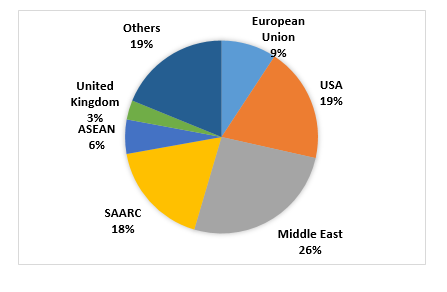

India enjoys a dominant global market position in turmeric. India remains the global leader in the production, exports, and consumption of this versatile spice. The golden spice, also known as Indian saffron, has gained prominence as a major component of spice exports from the country. The health benefits and immunity-boosting properties of the spice, though well-known globally, received a renewed attention in the wake of the COVID-19 pandemic. The total exports of turmeric rose sharply by nearly 41 percent between the triennium ending (TE) 2017-18 and the TE 2020-21. In absolute terms, the exports of dried turmeric alone increased by 36,110 tonnes during this short period (Table 1). The positive shift in demand for turmeric augurs well for the primary producers of the commodity in the country.
Table 1: The rising trend in turmeric exports from India
| Product category | Average quantity exported (tonnes) | Absolute change (tonnes) | Percent change | |
|---|---|---|---|---|
| 2015-16 to 2017-18 | 2018-19 to 2020-21# | |||
| Fresh turmeric | 7013 | 6747 | (-) 266 | (-) 3.8 |
| Dried turmeric | 52165 | 88275 | 36110 | 69.2 |
| Turmeric powder | 39469 | 43971 | 4502 | 11.4 |
| Turmeric oleoresin | 979 | 2071 | 1092 | 111.5 |
Note: The data for March 2021 is not included for the year 2020-21 Source: Compiled from Export Import Data Bank, Ministry of Commerce and Industry, Government of India
The highest rate of growth in exports was observed in turmeric oleoresin, a high value extract from turmeric, which finds application across several pharmaceutical and wellness products. The growth of processed extracts of turmeric in the export basket will also ensure more value addition opportunities and consequently, better employment generation within the country.
Another feature of the export gains in turmeric is the broad-based nature of the export destinations. During 2020-21, turmeric exported from India reached 162 countries across the globe. The source of export revenue from turmeric is depicted in figure 1. The major export destinations of Indian turmeric are European Union, Middle East, SAARC, ASEAN, USA, UK, Japan, etc.

Fig 1: Share of major export destinations in total export value of turmeric
The emerging trends in export markets
The increased global demand for turmeric and its value-added forms can be translated into better economic prospects for the primary producers as well as other stakeholders along the value chain. This requires understanding the emerging market preferences and trends in the global markets.
The increasing consumer awareness about food safety and increasing concerns about the sustainability of production practices across the globe translates into more stringent demands from export destinations. Increasingly stringent trade standards need not be a deterrent for turmeric exports. Quality control in the entire value chain, from farm to fork, starting right from the primary production till the product or commodity reaches the final consumer need to be ensured. The changes in consumer sentiments across global markets have also increased the demand for traceability systems across the turmeric value chain. It is imperative that our production systems adopt state-of-the-art traceability systems.
Farmer collectives like Farmer Producer Organizations (FPOs) can play a vital role to enhance the pace of technology dissemination for sustainable crop production, while playing a facilitating role in ensuring traceability of the produce.
In the sphere of processing, firms involved in the aggregation of turmeric bound for export and its processing need to adopt smart food safety management systems. This can ensure the uninterrupted movement of products along the value chain while ensuring the safety of both the consumers and the workers. Though we have come a long way in value addition efforts in turmeric, an exclusive focus on product development and innovation can enhance the range of value-added products while further enhancing the depth of the markets. The increased demand for turmeric may be rooted in its increased use in wellness and nutraceutical applications. The product development efforts must be able to synthesize indigenous traditional knowledge and modern scientific research to ensure better consumer acceptance for the new products.
Conclusion
The global demand for turmeric is witnessing an increasing trend and the pandemic is expected to have engineered a positive demand shift. Through broad-based and robust, the increased global demand is also accompanied by changes in market preference in export destinations. While they can raise significant challenges for the turmeric economy in the country, we can make prudent choices to address them effectively. A willingness to recalibrate our production, processing and institutional practices in tune with these trends will enable India to retain its pre-eminent position as a global leader in turmeric.
(Content shared by Dr. Lijo Thomas, Senior Scientist (Agricultural Economics), ICAR-Indian Institute of Spices Research, Kozhikode, Kerala)